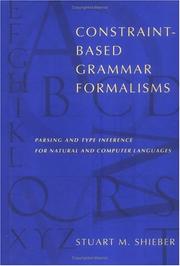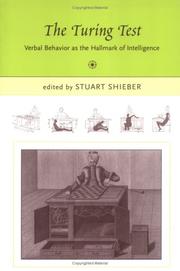| Listing 1 - 5 of 5 |
Sort by
|
Book
ISBN: 0937073008 0937073016 9780937073001 Year: 1986 Volume: 4 Publisher: Stanford (Calif.) : CSLI,
Abstract | Keywords | Export | Availability | Bookmark
 Loading...
Loading...Choose an application
- Reference Manager
- EndNote
- RefWorks (Direct export to RefWorks)
Psycholinguistics --- Grammar, Comparative and general --- Computational linguistics --- Grammaire comparée --- Linguistique informatique --- Data processing --- Informatique --- Computational linguistics. --- Data processing. --- Grammaire comparée --- Comparative grammar --- Grammar --- Grammar, Philosophical --- Grammar, Universal --- Language and languages --- Philosophical grammar --- Linguistics --- Philology --- Automatic language processing --- Language data processing --- Natural language processing (Linguistics) --- Applied linguistics --- Cross-language information retrieval --- Mathematical linguistics --- Multilingual computing --- Grammar, Comparative --- Grammar, Comparative and general - Data processing

ISBN: 0262193248 Year: 1992 Publisher: Cambridge, Mass. MIT
Abstract | Keywords | Export | Availability | Bookmark
 Loading...
Loading...Choose an application
- Reference Manager
- EndNote
- RefWorks (Direct export to RefWorks)
Mathematical linguistics --- Artificial intelligence. Robotics. Simulation. Graphics --- Grammar --- Computational linguistics --- Grammar, Comparative and general --- Parsing (Computer grammar) --- Programming languages (Electronic computers) --- Linguistique informatique --- Grammaire comparée --- Analyse automatique (Linguistique) --- Langages de programmation --- Data processing --- Syntax --- Informatique --- Syntaxe --- Grammaire comparée

ISBN: 0262283514 9780262283519 9780262513852 0262293110 0585315973 9780585315973 0262193248 9780262193245 Year: 1992 Publisher: Cambridge, Massachusetts : [Piscataqay, New Jersey] : MIT Press, IEEE Xplore,
Abstract | Keywords | Export | Availability | Bookmark
 Loading...
Loading...Choose an application
- Reference Manager
- EndNote
- RefWorks (Direct export to RefWorks)
Constraint-based theories of grammar and grammar formalisms are becoming an increasingly widespread area of research in computational linguistics. Constraint-Based Grammar Formalisms provides the first rigorous mathematical and computational basis for this important area. It introduces new applications to both natural and computer languages and brings together Stuart Shieber's many contributions that have been at the core of developments ranging from the discovery of improved explanations of linguistic phenomena such as binding and coordination to the detailed mathematical analysis of constraint-solving and parsing in a variety of grammar formalisms.This thorough examination of the theoretical and computational foundations of constraint-based grammars and applications to natural-language analysis is unique in several respects. Shieber's theoretical framework may be applied to a whole class of formalisms with properties that make it possible to define a general parsing algorithm for all members of the class, with results that provide essential guidance to the implementer of constraint-based language processing systems. Shieber also brings out new connections between grammatical categories and data types, and between constraint-based natural-language analysis and type inference in computer languages. These connections should be of increasing interest both to computational and theoretical linguists and to computer scientists.Stuart M. Shieber is Assistant Professor of Computer Science at Harvard University.
Parsing (Computer grammar) --- Programming languages (Electronic computers) --- Grammar, Comparative and general --- Computational linguistics. --- Automatic language processing --- Language and languages --- Language data processing --- Linguistics --- Natural language processing (Linguistics) --- Comparative grammar --- Grammar --- Grammar, Philosophical --- Grammar, Universal --- Philosophical grammar --- Parsers (Computer grammar) --- Syntax. --- Data processing. --- Data processing --- Grammar, Comparative --- Applied linguistics --- Cross-language information retrieval --- Mathematical linguistics --- Multilingual computing --- Philology --- Computational linguistics --- Formal languages --- Generative grammar --- Languages & Literatures --- Philology & Linguistics --- Syntax --- Computer languages --- Computer program languages --- Computer programming languages --- Machine language --- Electronic data processing --- Languages, Artificial --- Grammar, Comparative and general Syntax

ISBN: 9780262256971 0262692937 9780262692939 0262256975 Year: 2004 Publisher: Cambridge (Mass.) MIT press
Abstract | Keywords | Export | Availability | Bookmark
 Loading...
Loading...Choose an application
- Reference Manager
- EndNote
- RefWorks (Direct export to RefWorks)
"The Turing Test is part of the vocabulary of popular culture - it has appeared in works ranging from the Broadway play Breaking the Code to the comic strip "Robotman." The writings collected for this book examine the profound philosophical issues surrounding the Turing Test as a criterion for intelligence. Alan Turing's idea, originally expressed in a 1950 paper titled "Computing Machinery and Intelligence" and published in the journal Mind, proposed an "indistinguishability test" that compared artifact and person. Following Descartes' dictum that it is the ability to speak that distinguishes human from beast, Turing suggested testing whether machine and person were indistinguishable in regard to verbal ability. He was not, as is often assumed, answering the question "Can machines think?" but offering a more concrete way to ask it. Turing's thought experiment encapsulates the issues that the writings in The Turing Test define and discuss."--Jacket.
Turing test --- Artificial intelligence --- Machine theory --- CAPTCHA (Challenge-response test) --- Turing test. --- COMPUTER SCIENCE/Artificial Intelligence

ISBN: 0937073180 0937073172 Year: 1987 Volume: 10 Publisher: Stanford (Calif.) : Leland Stanford Junior University. Center for the study of language and information,
Abstract | Keywords | Export | Availability | Bookmark
 Loading...
Loading...Choose an application
- Reference Manager
- EndNote
- RefWorks (Direct export to RefWorks)
Programming --- Mathematical linguistics --- Computational linguistics --- Prolog (Computer program language) --- Linguistique informatique --- PROLOG (Langage de programmation) --- Automatic language processing --- Language and languages --- Language data processing --- Linguistics --- Natural language processing (Linguistics) --- Applied linguistics --- Cross-language information retrieval --- Multilingual computing --- Data processing --- Computational linguistics. --- Prolog (Computer program language). --- Linguistique --- Informatique --- Computer science --- Computer science. --- Linguistique mathematique --- Langages naturels
| Listing 1 - 5 of 5 |
Sort by
|

 Search
Search Feedback
Feedback About UniCat
About UniCat  Help
Help News
News